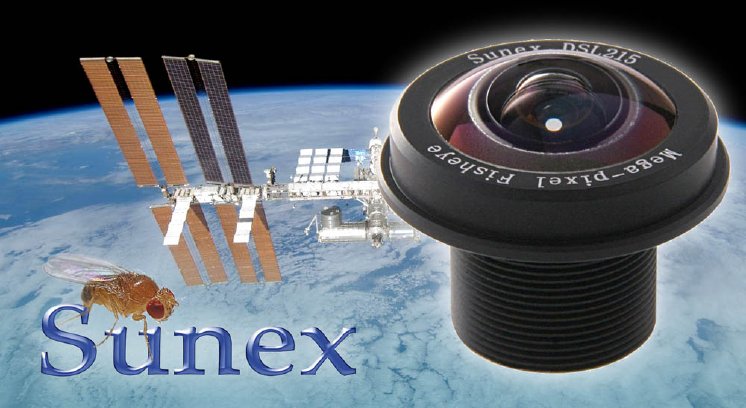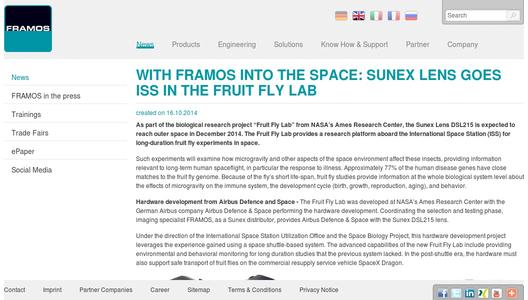Such experiments will examine how microgravity and other aspects of the space environment affect these insects, providing information relevant to long-term human spaceflight, in particular the response to illness. Approximately 77% of the human disease genes have close matches to the fruit fly genome. Because of the fly’s short life-span, fruit fly studies provide information at the whole biological system level about the effects of microgravity on the immune system, the development cycle (birth, growth, reproduction, aging), and behavior.
Hardware development from Airbus Defence and Space - The Fruit Fly Lab was developed at NASA’s Ames Research Center with the German Airbus company Airbus Defence & Space performing the hardware development. Coordinating the selection and testing phase, imaging specialist FRAMOS, as a Sunex distributor, provides Airbus Defence & Space with the Sunex DSL215 lens.
Under the direction of the International Space Station Utilization Office and the Space Biology Project, this hardware development project leverages the experience gained using a space shuttle-based system. The advanced capabilities of the new Fruit Fly Lab include providing environmental and behavioral monitoring for long duration studies that the previous system lacked. In the post-shuttle era, the hardware must also support safe transport of fruit flies on the commercial resupply service vehicle SpaceX Dragon.
Sunex observes in smallest space - The Sunex lens is used as part of the observation and lighting system within the experiment container housing the cassette that will safely transport fruit flies to the space station. The Fruit Fly Lab will provide long-term housing for fruit flies aboard the station at microgravity and a controlled 1g inside an on-orbit centrifuge. With Sunex’s DSL215 as a fish-eye objective, the camera monitoring the flies’ lifetime cycle is able to provide a 180° overview to optimize analytical output. The lens has a small form factor and supports implementing the cameras with minimum space requirements. With an all glass and metal construction, the DSL215 has greater performance stability over temperature for a proven environment stability. Following the severe NASA directives for components’ quality structure, the lenses had to be proven scientifically in manufacturing and state quality and had to pass a special quality assurance and safety audit to ensure space suitability.
Christian Bruderrek, Project Manager Life Science Orbital Systems & Space Exploration at Airbus Defence & Space, explains: “We at Airbus Defence & Space are the engineers providing the scientists with the technology to conduct their experiments. To gain reliable results and to collaborate with NASA it is extremely important to have reliable products like the Sunex lenses and to work with reliable partners like FRAMOS. We are happy our project will successfully fly into space with SpaceX5 mission scheduled for December and we are looking forward to the first measurements from the observation housings with the developed experiment container and cameras inside.”


